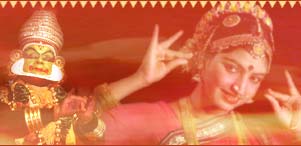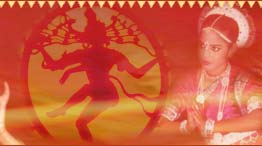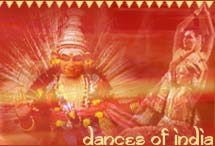Mohiniattam, one amongst the youngest Indian classical dances, came into being during the 16th Century A.D. By 19th Century, it was in its full form as it was boosted and encouraged by Swathi Tirunal, Maharaja of Trivandrum. The form is extremely sensual and graceful and is performed both solo and in a group by women. The term 'Mohini' means a beautiful maiden who enchants spectators and 'Attam' means dance; so 'Mohiniattam' is essentially an enchanting dance by a gorgeous maiden. There are two famous legends that are associated with the origin of the dance form. As per the first fable it is said that Lord Vishnu appeared in the form of an enchanting 'Mohini' to lure the demons away from the holy nectar of immortality (Amrit) that was churned out by the Gods and the Demons. In another instance, he comes as 'Mohini' to save Lord Shiva from the demon Bhasmasura. The dance is named after this legend and the hero of every performance is Lord Vishnu or his avatar, Lord Krishna.
History and Evolution
This wonderful dance originates from Kerala. The first reference to Mohiniattam has been found in 'Vyavaharamala', composed by Mazhamangalam Naryanam Namboodiri, assigned to the 16th century A.D. Mention of Mohiniattam is found in some eighteenth century texts as well, but the practical aspect of the style was revived in the reign of Maharaja Swati Tirunal, a 19th century ruler who was a great patron of the arts. Under Swati Tirunal, Mohiniattam crystallized as a solo dance tradition with musical compositions set to the Carnatic style of music and a distinct repertoire. Later, in the twentieth century, the great poet Vallathol established the Kerala Kalamandalam to promote the arts of Mohiniattam and Kathakali. Here, further research was done and Mohiniattam was collected.
Significance
Mohiniattam is a solo female dance (in a single costume), where musical melody and the rhythmical swaying of the dancer from side to side and the smooth and unbroken flow of the body movement is the striking feature. Lord Vishnu or Krishna is the hero in most of the recitals. The spectators feel His invisible presence when the heroine or her maid details dreams and ambitions, through the circular movements, delicate footsteps and subtle expression. Like many other dance forms, it is essentially dedicated to the love and devotion towards God, and is performed according to the rhythm of the song with subtle footwork and powerful hand gestures of the performer.
Attire and Makeup
The make-up and costume is realistic and simple. A white sari with golden brocade border is the usual costume. It is teamed with gold jewelry like elaborate earrings, an elegant necklace, a gold waistband, bangles, armlets, etc. The make-up emphasizes on the eyes and they are beautifully lined and made to look sensual.
Postures
The movements in Mohiniattam are never abrupt- they are dignified, easy and natural. However, while dancing, never is the vertical line of the body broken. The dance form has 40 basic movements. The performer uses her eyes to enchant the mind without exciting the senses. The hand gestures used in Mohiniattam are very important as a communicative gesture.
Music
The style of vocal music for Mohiniattam has generally been seen as classical Carnatic. The lyrics are in Manipravala (a mixture of Sanskrit and Malayalam). Earlier, Thoppi Maddalam and Veena provided the background music of Mohiniattam. These have been replaced, in recent years, by the Mridangam and Violin.
Famous Personalities
A leading exponent of Mohiniattam, Sunanda Nair has emerged as one of the few practicing luminaries of this style of classical Indian dancing. Jayaprabha Menon's dance has brought a new aesthetics to Mohiniattam. Pallavi Krishnan is a leading exponent of the dance form along with Gopika Verma.




